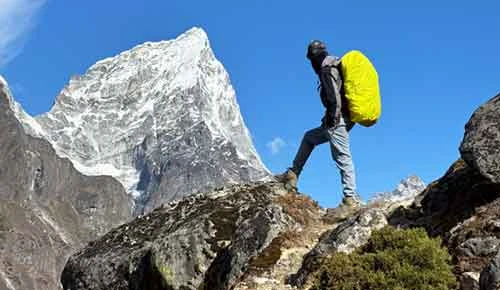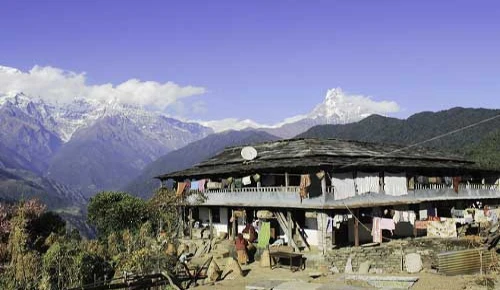Practical Guide to EBC Trek: Pre and Post Trek Activities
The Everest Base Camp Trek is a big deal for adventure seekers worldwide. People come from everywhere to experience the stunning views and face the challenge of reaching the base camp below Mount Everest in the Himalayas. This journey is no walk in the park; it requires strength, a tough mindset, and good planning.
This trek is challenging, and it's important to be well-prepared. In addition to training and packing the right gear, there are a number of pre- and post-trek activities that can help you make the most of your experience.
This blog is here to help you get ready for the trek and make the most of it, covering what to do before and after. Whether you're getting excited for the adventure or looking back on it, this guide has practical tips to keep you informed and safe during your hiking trip.

Table of Contents
Pre-Trek Activities
In the context of the EBC Trek, the pre-trek activities are crucial for ensuring a successful and enjoyable journey. This section focuses on the necessary preparations individuals should undertake before starting the adventure.
Physical Preparation
Physical preparation is a crucial aspect of getting ready for a challenging ascend like Everest Base Camp (EBC). It involves activities aimed at improving your overall physical fitness, stamina, and strength to endure the demands of the trekking environment. Here's a brief overview of the key components of physical preparation:
| Type of Training | Objective | Activities/Exercises |
|---|---|---|
| Cardiovascular Training | Enhance cardiovascular endurance for long-distance walking at various altitudes | Running, cycling, swimming, and aerobic exercises |
| Strength Training | Strengthen key muscle groups, especially in the lower body, for uphill and downhill trekking | Squats, lunges, leg presses, calf raises, core exercises |
| Endurance Exercises | Improve ability to endure prolonged physical activity, replicating the conditions of a long trek | Extended hiking, brisk walking, other forms of aerobic exercise for extended periods |
Physical preparation is not only about building strength but also about conditioning your body for the specific demands of trekking, including varied terrain, altitude changes, and extended periods of walking. Consistent and progressive training in these areas will significantly contribute to your ability to enjoy and successfully complete the trek.
Mental Preparation
Mental preparation is a crucial aspect of getting ready for the trek. It involves developing the right mindset and psychological resilience to cope with the challenges of the journey. Here's a brief overview of key elements in mental preparation:
| Aspect | Description |
|---|---|
| Understanding Challenges | Researching potential difficulties during the trek, including high altitudes, variable weather, and physically demanding terrain. |
| Being aware of risks associated with altitude sickness and knowing how to recognize and manage its symptoms. | |
| Developing a Positive Mindset | Cultivating a positive attitude, viewing the trek as an adventure rather than just a physical challenge. |
| Recognizing and approaching obstacles with optimism and a problem-solving mindset. | |
| Learning Basic Trekking Skills | Acquiring fundamental trekking skills, such as using trekking poles, reading trail markers, and pacing oneself on the trail. |
| Being mentally prepared for the physical exertion involved, understanding uphill and downhill segments of trekking. |
Mental preparation is about creating a strong mental foundation that allows trekkers to stay focused, positive, and resilient throughout the journey. This mindset not only contributes to personal enjoyment but also enhances the ability to overcome challenges and fully appreciate the unique experience of trekking.
Gear and Equipment Preparation
Gear and equipment preparation is also a crucial aspect of getting ready for the trek. This involves ensuring that you have the right tools and clothing to navigate the challenging terrain and varying weather conditions of the trek. Here's a brief overview:
Essential trekking gear:
- Trekking boots: sturdy and comfortable boots that provide ankle support for long walks on uneven terrain.
- Backpack: A durable backpack with sufficient capacity to carry your essentials, including a water bottle, snacks, extra clothing, and personal items.
- Sleeping bag: appropriate for the expected temperatures during the trek, ensuring a comfortable night's sleep at higher altitudes.
- Trekking poles: Useful for stability and balance, especially during steep ascents and descents.
Clothing considerations:
- Layered clothing: Pack layers to accommodate varying temperatures, including a moisture-wicking base layer, an insulating mid-layer, and a waterproof outer layer.
- Insulating jacket: a warm, lightweight jacket for colder conditions at higher elevations.
- Headwear and gloves: a hat to protect against the sun and cold, as well as gloves for warmth during chilly weather.
Other essentials:
- Sleeping pad: providing insulation and comfort during nights in teahouses or campsites.
- Sunglasses and sunscreen: protecting against the strong Himalayan sun at higher altitudes.
- Water purification system: ensuring access to clean drinking water throughout the trek.
Renting vs. buying equipment:
- Cost considerations: Evaluate whether it's more economical to rent certain gear at your destination or purchase it beforehand.
- Personal preference: Some trekkers prefer using their own equipment for comfort and familiarity.
Careful consideration and preparation regarding gear and equipment contribute significantly to the comfort, safety, and overall success of the trek. Ensuring that you have the right tools for the journey can make a substantial difference in your overall experience.
Post-Trek Activities
Post-trek activities are the practices and actions that individuals engage in after completing a voyage. These activities are crucial for promoting recovery, reflecting on the experience, and ensuring a healthy transition back to regular life. Here's a brief overview of post-trek activities
Recovery Strategies
Recovery strategies are methods and practices aimed at helping individuals recuperate physically and mentally after engaging in strenuous activities such as trekking, ensuring that the body and mind return to a state of balance and well-being. In the context of trekking, and specifically after completing a challenging trek like the Everest Base Camp, recovery strategies play a crucial role. Here's a brief explanation of recovery strategies:
| Aspect | Description |
|---|---|
| Rest and Relaxation | Adequate rest is fundamental for recovery post-trek, allowing the body time to repair and rebuild muscles. Quality sleep is crucial for releasing growth hormone and promoting overall physical and mental recovery. |
| Post-Trek Exercises | Gentle stretching and low-impact exercises can alleviate muscle stiffness and prevent soreness. Targeted exercises focusing on areas that underwent significant strain during the trek aid in maintaining flexibility and mobility. |
| Massage and Therapy | Professional massages or self-massage techniques like foam rolling promote blood circulation, reduce muscle tension, and accelerate recovery. Therapeutic practices such as yoga or meditation contribute to both physical and mental relaxation. |
| Hydration and Nutrition | Rehydration is essential after physical exertion. Drinking water helps restore fluid balance and supports various bodily functions. Nutrient-rich meals, with a balance of carbohydrates, proteins, and healthy fats, contribute to muscle recovery and replenish energy stores. |
| Temperature Management | Heat and cold therapies, like ice packs or warm baths, can manage inflammation and soothe sore muscles. Saunas or hot baths may help relax muscles and enhance overall well-being. |
| Gradual Return to Activity | Instead of immediately returning to intense activities, a gradual reintroduction of exercise allows the body to adapt and reduces the risk of injury. Listening to the body's signals and adjusting the level of activity accordingly is crucial during the recovery period. |
Specific Things to Do in Kathmandu Before and After Your Trek
Nepal has also been in a lot of movies, including the most popular one, Doctor Strange (2016). It has scenes from these temples: Kathmandu Durbar Square, Pashupatinath Temple, and Swayambhunath Temple, so you might even feel chills seeing them with your own eyes.
Before the Trek:
- Explore the lively Thamel district for its diverse range of shops, restaurants, and cultural offerings.
- Obtain the necessary trekking permits and a TIMS card in Kathmandu before heading to the trekking region.
- Discover the historical architecture, palaces, and traditional Nepali art at Kathmandu Durbar Square.
- Purchase any last-minute trekking gear or equipment you may need from the numerous stores in Thamel.
- Visit the iconic Swayambhunath Stupa, also known as the Monkey Temple, for its religious significance and panoramic views.
After the trek:
- Unwind in the peaceful Garden of Dreams, offering a serene environment for post-trek relaxation.
- Try traditional Nepali dishes in local restaurants, savoring momo, dal bhat, and other authentic delights.
- Explore Boudhanath Stupa, one of the largest stupas in Nepal, known for its unique mandala and vibrant atmosphere.
- Experience Nepali culture through traditional dance performances or cultural shows held in Kathmandu.
- Engage in a thangka painting workshop to create your own traditional Tibetan Buddhist scroll paintings.
- Take a day trip to Patan, a city with its own Durbar Square, ancient temples, and rich cultural heritage.
- Explore Pashupatinath Temple along the Bagmati River, witnessing traditional Hindu rituals and ceremonies.
- Purchase souvenirs such as traditional handicrafts, textiles, or local artwork from the markets in Kathmandu.
Specific Things to do in Pokhara
Before Your Trek:
- Visit Phewa Lake for a peaceful experience and a possible boat ride.
- Hike to Sarangkot for breathtaking views.
- Explore the World Peace Pagoda, symbolizing tranquility.
- Discover the history of mountain exploration at the International Mountain Museum.
- Take a cooking class to learn local cuisine.
- Enjoy shopping for unique souvenirs.
After Your Trek:
- Visit Davis Falls, a fascinating waterfall with a unique geological history.
- Experience whitewater rafting for an adrenaline rush.
- Explore the intriguing Mahendra Cave and its natural formations.
- Try paragliding for an adventurous perspective of the landscapes.
Conclusion
In summary, the Everest Base Camp Trek is an extraordinary adventure that goes beyond the physical challenge. Preparing adequately with physical training, obtaining the right gear, and exploring Kathmandu enhances the experience. Post-trek activities like rest, massages, and cultural exploration in Kathmandu add depth and reflection. The journey, with its pre- and post-trek facets, weaves a rich tapestry of memories, making the trek a transformative and unforgettable adventure.








